

Geoff’s Narrations
The GIST
The Blog
Jarred Younger has been waiting for 20 years for the new technology he talks about in his “Reaching Deep Into the Brain” video from his Pain and Fatigue Lab at the University of Alabama at Birmingham.
Some of us have been waiting a lot longer than that (lol), but Younger’s long wait underscores something important. For most of us, the answer probably lies in the development of better technologies, and those technologies simply haven’t been available.
THE GIST
-
The tFUS device. An at-home device is being developed.
Jarred Younger’s research suggests that neuroinflammation in the brain plays a significant role in ME/CFS, fibromyalgia, and long COVID.
- He’s been waiting for 20 years for a brain stimulation device that can reach deep enough in the brain to impact the areas that play a role in ME/CFS, fibromyalgia, and long COVID.
- In a “Reaching Deep Into the Brain” video from his Pain and Fatigue Lab at the University of Alabama at Birmingham, Younger described how transcranial focused ultrasound (tFUS) devices use sound waves to precisely reach deep into the brain.
- These devices can, among other things, switch the microglia from an inflammatory to an anti-inflammatory state.
- In a second video, “Focused ultrasound reduces chronic pain,” Younger reviewed the results of a recent study which found that tFUS dramatically reduced pain levels in 60% of the participants. The effects were especially noteworthy given the wide variety of pain conditions found in the study, the focus on one specific area of the brain, and the lack of clarity regarding the best dose and duration of the treatment.
- The study targeted a part of the brain – the subgenual region of the anterior cingulate cortex (ACC) – that has repeatedly been linked to fatigue and pain problems in ME/CFS, fibromyalgia, and long COVID studies.
- Called the “brain’s alarm center”, the ACC appears to be wired for threat detection. A core component of the descending pain inhibitory pathways, damage to the ACC could result in increased pain sensitivity. By the same token, the ACC’s connection to the salience network could result in increased fatigue.
- Because the ACC regulates the autonomic nervous system via its connections to the brainstem and the hypothalamus, dysautonomia is a likely result as well.
- Interestingly, the ACC may be more quickly and intensely impacted by peripheral inflammation (inflammation in the body) than any other organ in the brain. (Peripheral inflammation appears to be particularly effective in producing neuroinflammation in several areas of the brain implicated in these diseases.)
- Whether the tFUS can be used to directly impact the brainstem – an area of great interest in these diseases – is unclear, but it can impact brainstem activity by targeting areas above it.
- Once Younger decides on which device to use, he will test it as quickly as possible. If he obtains good early results, expect a clinical trial to conclusively determine how effective it is in these diseases.
- These devices are already in the process of getting FDA approval, and Younger expected “multiple devices to be available quite soon.” Younger ended by saying, “It’s really exciting to see the rapidly advancing technologies”.
- It goes without saying how lucky we are to have Younger in our corner. With Younger, we don’t have to wait for advances in brain stimulation like tFUS to filter down over a decade or two to diseases like ME/CFS and fibromyalgia (FM).
- Time will tell how the tFUS saga goes, but it’s yet another reminder that the technology is moving very quickly and we can’t predict what the future will bring.
Please Support Health Rising and Keep the Information Flowing
Neuroinflammation Buster?
As many people are aware, Jarred Younger is a neuroscientist whose research suggests that microglial and astrocyte-produced neuroinflammation in the brain plays a significant role in ME/CFS, fibromyalgia, and long COVID. We know these diseases are “brain diseases”. We don’t know if the brain is where they start or if the brain is the smoking gun, but we do know that the brain and the central nervous system are significantly affected.
There’s also no doubt that the microglia/astrocytes in the brain that Younger has been so focused on for the past ten years are involved in chronic pain, and probably fatigue. In 2023 ,Younger stated that he was surer than ever that neuroinflammation plays a major role in these diseases.
Getting at these microglia, though, has been hard. Many drugs and supplements can’t cross the blood-brain barrier. Non-invasive neuromodulatory techniques are a possibility, and several (transcranial direct current stimulation (tDCS), repetitive Transcranial Magnetic Stimulation (rTMS), Transcranial Alternating Current Stimulation (tACS)) have been tried in ME/CFS/FM. The results have generally been moderate.
One problem has been their inability to penetrate deeply and precisely enough to reach some the structures of the brain that studies show us are involved in these diseases. While these techniques are getting more precise and effective, Jarred Younger is not abuzz about them. He is abuzz, though, about something called transcranial focused ultrasound (tFUS).
Transcranial Focused Ultrasound (tFUS)
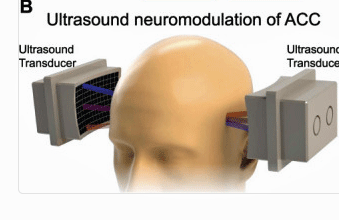
The tFUS device. An at-home device is being developed.
Instead of using magnets, tFUS uses high-frequency sound waves to reach – and this is the key point – any part of the brain…The small wavelengths of the sound waves allow for greater precision than can be achieved with magnets.
By sending sound waves from multiple directions, Younger said that tFUS can precisely modulate neuronal activity. How precise? This technique can open a specific part of the blood-brain barrier, allowing a drug to pass through at that precise part of the brain. The clincher for Younger, though, is tFUS’s ability to switch the microglia from an inflammatory to an anti-inflammatory state.
Since lower intensity soundwaves inhibit neurons while higher intensity soundwaves have an excitatory effect, tFUS has the capability to turn on or off neurons across the brain. In effect, tFUS has the potential to reset malfunctioning brain circuits.
The University of Utah Study
“Targeted noninvasive modulation of deep brain circuits has long been a dream of neural sciences.” the authors
In a second video, Younger went over the main points of a recent study, “Noninvasive targeted modulation of pain circuits with focused ultrasonic waves” from the University of Utah in Salt Lake City.
The study involved a wide variety of chronic pain patients, many of whom had multiple pain conditions. Note that many of these are associated with each other. They included fibromyalgia (10), myofascial pain syndrome (4), generalized pain syndrome (4), migraines (3), back pain (3), neuropathy (3), arthritis (3), chronic fatigue syndrome (2), complex pain syndrome, piriformis syndrome, atypical trigeminal neuralgia, cervical myelopathy, shoulder pain, foot pain, joint pain, endometriosis, scleroderma, dysautonomia, common variable immunodeficiency, temporomandibular joint dysfunction, Guillain–Barré syndrome, Crohn’s disease, and post-cancer pain (!).
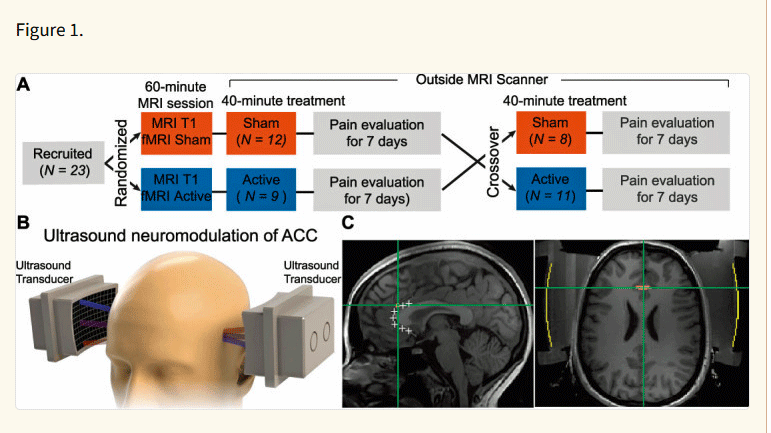
Note how precise tFUS is (brain image lower right).
Given the wide variety of conditions, this might not seem like the best group to test a treatment. The researchers clearly thought, though, that fTUS could tackle a wide variety of pain conditions.
First, they did an MRI to determine their target. (The authors believe that, at some point, MRIs will not be required.) In this crossover study, each of the participants, for 40 minutes, received tFUS and a sham procedure twice over a week. During each procedure (real/sham), they were followed for a week.
Results
“The results demonstrate that it is possible to modulate deep brain structures in humans precisely, non-invasively, and in a controlled manner.” The authors
Sixty percent of subjects experienced a clinically meaningful reduction of pain on day 1 and on day 7 following the active stimulation, while sham stimulation provided such benefits only to 15% and 20% of subjects, respectively. On average, the ultrasound reduced pain by 60% immediately, which dropped to 30% by the end of the week.
Younger considered the results impressive given how early we are in this process. Despite the study’s wide variety of conditions, its focus on a specific area, the potential for other areas to work better, and the unknown optimum dose or timing of stimulation, the study still managed to produce significant reductions in pain very quickly. Younger was clear that this is only the beginning and that fTUS will only get more effective over time.
Anterior Cingulate Cortex – Neurological Ground Zero for Post-Infectious Diseases?
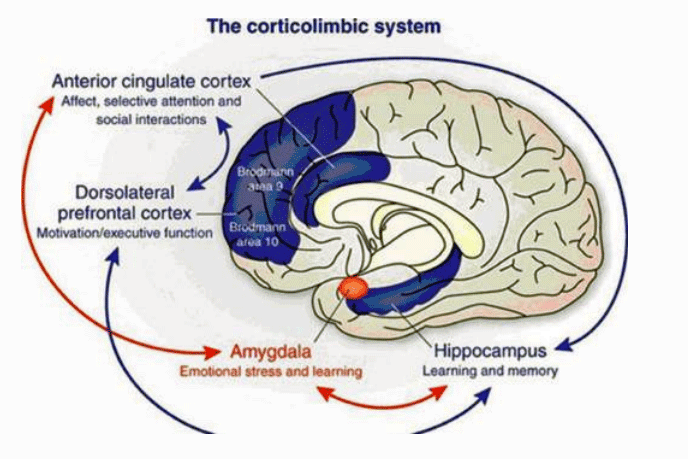
(Image from Benes 2010 corticolimbic system Wikimedia Commons)
The Utah researchers targeted the same region of the brain – the subgenual region of the anterior cingulate cortex (ACC) – that Younger said would have been his first choice.
It’s no wonder. The ACC appears to be perfectly positioned to influence key brain regions in these diseases. The ACC is like a hub around which the prefrontal cortex – the seat of executive functioning – and the limbic system (fight/flight) revolve.
Called the “brain’s alarm center”, the ACC appears to be wired for threat detection. If the connection between the prefrontal cortex and the ACC breaks down, as it appears to have in these diseases, and the prefrontal cortex can’t talk to the ACC, the limbic system, with its fight/flight tendencies, is given full rein. A core component of the descending pain inhibitory pathways, damage to the ACC could result in increased pain sensitivity.
By the same token, the ACC’s connection to the salience network could result in increased fatigue. Because the ACC regulates the autonomic nervous system via its connections to the brainstem and the hypothalamus, dysautonomia is a likely result as well.
Interestingly, the ACC may be more quickly and intensely impacted by peripheral inflammation (inflammation in the body) than any other organ in the brain. (Peripheral inflammation appears to be particularly effective in producing neuroinflammation in several areas of the brain implicated in these diseases (hippocampus, ACC, cerebellum, amygdala and substantia nigra (basal ganglia).)
A hyperactive ACC produces pro-inflammatory cytokines that create a feedback loop which triggers more neuroinflammation. Levels of excitotoxic brain chemicals, such as glutamate, increase, while levels of calming brain chemicals, like GABA, decrease.
The ACC in ME/CFS, Fibromyalgia and Long COVID
In FM, the ACC appears to be disturbed in every which way. Decreased gray matter and connectivity in the ACC, decreased connectivity to the prefrontal regions outside the ACC, and elevated markers of neuroinflammation in the ACC have been found in FM.
Altered metabolite levels, reduced cerebral blood flows, and reduced acetylcarnitine uptake have been linked to fatigue, as well as problems with motor planning (movement) in ME/CFS.
Note that a small study found that six weeks of creatine supplementation increased creatine levels in the ACC and decreased fatigue in ME/CFS.
Similar abnormalities have been found in long COVID (reduced glucose metabolism, neuroinflammation, decreased connectivity).
All in all, ACC issues have been associated with pain, fatigue, and cognitive deficits in these diseases. Indeed, an AI Perplexity analysis suggested that the ACC could be the neurological ground zero for post-infectious illnesses.
Going Even Deeper?
Could tFUS go even deeper and modulate activity and reduce inflammation in that most intriguing part of the brain – the brainstem? Animal studies suggest it can hit the brainstem, but human studies are apparently a ways off. Still, targeting areas upstream of the brainstem, such as the amygdala, has allow tFUS to affect brainstem activity.
The Future
Multiple devices are being produced, and Younger is currently deciding which one he wants to test in these diseases. Once he gets it, he will test it as quickly as possible. If he gets good early results, expect a clinical trial to conclusively determine efficacy in these diseases.
These devices are already in the process of getting FDA approval, and Younger expected “multiple devices to be available quite soon”, and at some point, we can expect devices to be used at home. Younger ended by saying, “it’s really exciting to see the rapidly advancing technologies”.
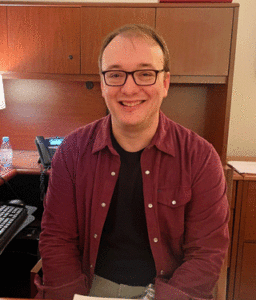
Jarred Younger – we are lucky to have him.
It goes without saying how lucky we are to have Younger in our corner. Younger’s record of innovation – the low-dose naltrexone studies, the dextronaltrexone work underway, the new thermal mapping technique, the immune invasion of the brain work (unpublished as of yet), the Good Day/Bad Day studies, the psilocybin trial, etc. – has been remarkable.
With Younger, we don’t have to wait for advances in brain stimulation like tFUS to filter down over a decade or two to diseases like ME/CFS and fibromyalgia (FM). Take the small fiber neuropathy saga. Given its presence in FM, it made sense for it to be present in ME/CFS, but it took the ME/CFS field six years after SFN had been found in fibromyalgia to start to look for it. Compare that to Younger’s outreach to industry BEFORE the devices have received FDA approval.
Time will tell how the tFUS saga goes, but it’s yet another reminder that the technology is moving very quickly and we can’t predict what the future will bring.


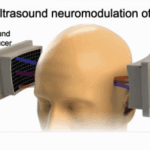

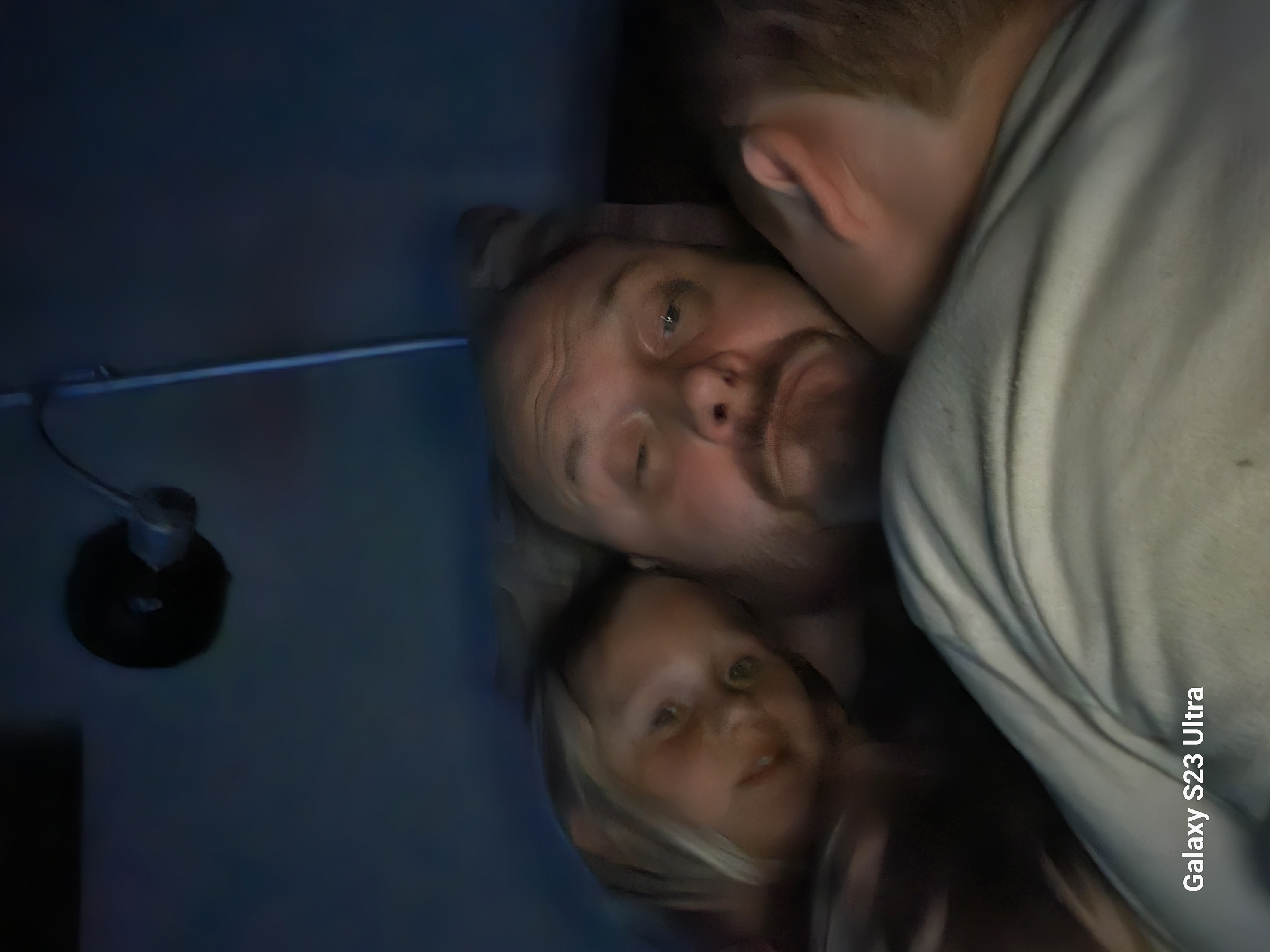

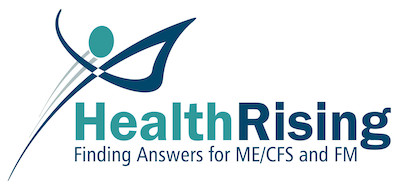
Thank you, Cort.
There are 2 shining beacons in my ME/CFS universe: Jarred Younger and Cort Johnson. These beacons give me hope, even after 40 years battling ME/CFS, that an effective treatment will arrive.
I ain’t giving up now!! 🙂
Me neither! Thanks!
Bob, I agree completely and Never giving up!!
I agree!
I agree with you, Bob, only I am not capable of real optimism anymore for my own condition and outlook. 30 years of struggle and trying to adapt to each downgrade in capacity and increase in pain. The cavalry isn’t going to arrive in time to save a span of productive life for me. BUT, my intuition is that Jarred Younger is on the right track. Precisely targeted sound waves will do the trick to reduce the distress and pain amplification process in the brain that these conditions involve. Not a pill, sound waves that can talk to the brain in its own kind of language and help it restore normal settings again. I imagine this will involve repeated treatments to improve, stabilize or reset the pattern going on. But even temporary resets would be well worth it to our beleaguered crew, and with a home device, we could repeat the helpful signal.
I’m with you, Cecelia…
I’m too far gone after 40 years and a near lifetime as an invalid. But just as you said, I am so thrilled there is hope and they are on the right track. At least now patients are more apt to at least be believed, hopefully.
Amen! It felt ironic that Cort shared Jarred’s research, as I’ve been following his “thinking” for awhile!
My compliments exactly… Cort, Jarred + Klimas are BEACONS of HOPE indeed!
Wow, exciting stuff. Thanks Dr Younger, and Cort for writing the article.
I have always found it interesting that I have never really had pain with my ME/CFS. My daughter doesn’t either.
So I wonder if this could potentially help fatigue as well as pain?
Is neuroinflammation at play only when there is pain? Or is it possible to have neuroinflammation leading to significant fatigue but not pain?
Some people with ME/CFS don’t experience pain – and yes, Younger believes fatigue is tied to neuroinflammation. He believes the symptoms found in these diseases are caused by microglial activation in different parts of the brain – so yes, if you have microglial activation/neuroinflammation in a part of the brain that’s really good at producing fatigue – you would have fatigue dominant ME/CFS.
Thanks Cort.
Do you know which part of the brain is implicated more for fatigue, versus pain?
Fascinating. I wonder if it can be done in a way that does not open the blood-brain barrier as doing so in ME/CFS sounds like a very bad thing and could let in undesirable circulating compounds.
I interpreted the mention of opening the blood-brain barrier at specific locations as a separate example of how fTUS is used, not that it is an unavoidable effect of the treatment. It illustrates the precision with which the treatment can be targeted. In the paper, they target the anterior cingulate cortex rather than the BBB.
That’s my understanding – it’s a specific treatment target – not an unwanted side effect.
I have FM. I can feel neuroinflammation increasing in my head at night even though I sleep with my head elevated. I can feel the pressure in the front as stiffness increases at the base of the skull. I have also lost my eyebrows probably due to poor circulation in the area. I also get a stuffy nose that goes away when I get up. I have found that pea-lut reduces but does not eliminate the inflammation.
I wonder if this ultrasound modulation treatment, by reducing neuroinflammation, could make us less susceptible to other neurodegenerative diseases like Parkinson’s.
I also wonder if reducing neuroinflammation would allow people to get better quality and/or quantity of sleep, which may in turn, result in less neuroinflammation.
If these devices work I would be shocked if they didn’t help with better sleep. As you point out poor sleep results in more inflammation and as Mardi pointed out, reducing inflammation anywhere in the body could take pressure off the ACC and other brain organs that are susceptible to it.
Just a question I had while reading your comment….are you sure it’s inflammation because what you described are also the symptoms of intra-cranial hypertension. ?? Eye brow loss could be hormonal too. ICH squeezes the brain and messes up a lot of different processes. 🙁
I was also curious if tFUS might have an off-target effect on reducing intracranial hypertension.
Loosing eyebrows. Check for Hashimotos and Hypothyroidism. Just a thought.
I’ve had ME/CFS with pain for years and now have turned up with an Atypical Parkinson’s too. Did I always have a synucleinopathy or did this develop as a result of ME/CFS—meaning, whatever was awry in my brain that caused that first symptom picture?
Thanks Cort.
Could this help the severe sensory ear and eye problems some get which does cause pain?
Since it has the potential to shut down or reduce central sensitization I would think, if the device works out, yes. If Younger is right and the area of the brain that controls the sensations in your ears and eyes is inflamed this device could, if targeted correctly and if it works, relieve them
This research offers exciting possibilities for future treatment outcomes.
In the mean time, for many, lifestyle, diet, titrated exercise and supplements offer positive outcomes over time.
Lifestyle and diet are key to reducing sources of inflammation. Mitochondrial support supplements are useful in the process of healing.
These thoughts are addressed in a number of freely available posts here: https://longcovidjourney2wellness.substack.com/
“Titrated exercise” just call it GET already and please don’t offer it to people who experience PEM.
Greetings Tim,
Titrated means that the amount of any measure is adapted to the needs of the individual.
It requires that the individual uses common sense, gradually adding whatever is possible for them, without inducing PEM. It took me nearly two years before I was able to walk each day from my house to the lower gardens behind my house.
My posts includes explanations of PEM. Have a look and see what you think. Do I
address it adequately?
https://longcovidjourney2wellness.substack.com/
@Mardi Crane-Godreau Living with ME is a perpetual balancing act. So a proportionate level of exercise is good for milder cases but to more severe ones it is often detrimental as they can be at a place that no amount of activity is tolerable. In those cases managing your particular ME problems is the way to regain the ability to exercise later on. Otherwise your body falls into a downward spiral of new worse symptoms. That means some degree of de-conditioning becomes unavoidable and one must try to keep it under control until there is a stable improvement.
I have been there several times so I have hard proof it was not the non-existing exercise what put me out of such tough spots.
So I hope you understand it is not the exercise itself that improves ME but a consequence of managing ME itself that allows your body to increase your tolerance to exercise or any other activity for that matter whether is mental or physical (aka energy envelope).
Hi Reflex,
I guess that I’m having difficulty communicating.
I have tried to be clear about the definition of the word titration. It does not mean or even imply, that any specific amount of exercise is used. The dose can be zero exercise. A titrated dose (of anything) meets the needs of the individual.
I invite you to have a look at some of my posts. A simple place to start is one called TLC for Mitochondria. It is, as you mention, about managing a chronic situation. I describe my personal lifestyle, diet, supplements, stress management and PEM.
I reference other resources and meaningful peer reviewed publications. It is freely available to all.
It’s taken me nearly 5 years to get back to a balanced life. It does require ongoing self-discipline and insights. I hope that my experience will help to shorten the journey for others.
https://longcovidjourney2wellness.substack.com/p/long-covid-tlc-for-mitochondria
@reflex – I was triggered when I saw this post and your explanation was appreciated! 😎🙏🏼
Mardi Crane-Godreau: I totally agree!
I can’t believe in 2025 people still promote “lifestyle”, diet, GET and whatever fancy supplements to deal with ME/CFS…
Many of us struggle to go from their bed to the loo.
Tired of the ‘one-asparagus-a-day-happiness-all-the-way’ gang who are loud and a great disservice to patients.
Greetings Isa,
I’m so sorry for your pain and frustration, but I’m not part of a ‘gang’. I’m an LC individual, also an immunologist with a strong background in endocrinology and neuroscience. I write in my public posts about what I know has worked for me and for some other individuals who have post-viral syndromes. I was one of them and apparently, so are many of the individuals who subscribe to my posts.
While there are similarities, I think that it’s also important to acknowledge that recuperation from ME/CFS may differ from recovery from Long COVID.
I am not familiar with ‘GET’. Please enlighten me.
Regarding ‘titration’; it is not a program. The word titration means to provide a dose that meets the needs of the individual. In medicine, it is normally used in discussing the dosing of medications. Titrated activity meets the needs of the individual at their speed and according to their needs. Ideally, it should be self-directed and based on common sense. This may be simply “walking to the loo” or standing up for a few minutes at a time. It took me more than 2 years to regain the ability to walk the length of my lawn.
I regained my health after making significant changes in my diet and focusing on nutrients (some as supplements) that support my mitochondria and overall normal metabolism.
I do understand the difficulties. I also understand the biochemistry of what is happening in many people with these syndromes. Lifestyle and diet can support healing or keep a person locked in illness. Stress, which can induce inflammation, is also part of the picture.
Denial and ignorance can be the worst enemies of wellness.
My work is based on peer reviewed science. It is freely available to those who seek solutions. I don’t sell any products, only discuss what has helped me regain my health.
https://longcovidjourney2wellness.substack.com/
I wish you speedy recovery.
Kind regards,
Mardi
GET/ Graded Exercise Therapy (GET) is a training program that increases exercise in small increments on a day-to-day basis. It is usually accompanied by CBT (cognitive behavioral therapy), a psychotherapeutic program designed to correct ” false illness beliefs.” The CBT part is what really sets people off because ME/CFS is NOT psychological. And GET has been debunked for ME/CFS multiple times. https://www.healthrising.org/blog/2020/11/13/nice-discards-graded-exercise-therapy-cbt-treatment-chronic-fatigue-syndrome/. When your mitochondria don’t work, exercise is not going to help and only makes things worse. And doing “just a little” doesn’t fix the mitochondrial issue.
Greetings T Allen,
Thank you for telling me about GET.
If GET is what you describe, I agree with you and others who have criticized it. What you describe is NOT titrated exercise, it’s a program that assumes that traditional methods of rehabilitation will work. Also, CBT has a very poor track record in many areas of psychological and pyschotherapeutic intervention.
Clearly, individuals with Long COVID and ME/CSF are not suffering from false illness beliefs! They have biological changes that make them ill.
Repeating what I mentioned previously, the word titration means to use a dose (of a medication or intervention) that meets the needs of the patient. It is not a program.
My posts at Substack are a reflection of my own journey of recovery from Long COVID as a scientist and a patient. They are written to provide relevant and useful insights to readers. There is no cost. They are my sincere efforts to reduce suffering.
I write about what has worked for me and for many others.
https://longcovidjourney2wellness.substack.com/
Kind regards,
Mardi
And thank you for confirming my belief that CBT is a crock of you know what! It’s the VA’s preferred method of treatment for any psychological issues and I thought it was a joke. Just an FYI, in case you know anyone who might need real trauma psych help, EMDR (Certified practitioner of course) can accomplish more in one sitting than months of CBT and I have personal knowledge of it’s positive impact on 5 other veterans. Of course it helps non-veterans as well. Thanks for your posts!
@T Allen,
Yes, in my view CBT is not the best solution to resolving trauma in many instances.
My prejudice leans to Somatic Experiencing Trauma Therapy.
https://www.frontiersin.org/journals/psychology/articles/10.3389/fpsyg.2015.00093/full
Somatic Experiencing: using interoception and proprioception as core elements of trauma therapy. (By way of disclosure, I’m the senior author on this paper.)
Regarding EMDR: for some individuals with trauma, it can significantly reduce the symptoms. However, I’m aware of unpublished reports that for individual whose trauma involved blows to the face, it can send the person into shock.
One day at a time! Thanks for your response.
I did somatic experiencing as well and it definitely a good adjunct to EMDR. I’ll read your paper, thanks! And just so you know. EMDR can be done without the eye movement. I used hand held “tappers” which automatically alternate Lft/Rt, controlled by the therapist of course. I believe the timing and intensity can be set per the patients comfort and the therapist controls the on/of while they ask questions. You should try it sometime for yourself so you would experience how it works. You can do it for any bad memories not just what would be termed “trauma”. Thanks again!
I’m sure you mean well Mardi, but frankly, I resent the hijacking of comments for self-serving self-promotion.
Repeatedly re-linking one’s website in a thread is surprisingly unprofessional and diverts attention from Cort’s article on Jarred’s work on tFUS and the ensuing discussion. Please… just don’t.
For me, I came here to read this article as an alternative to exploring euthanasia, as I am beyond depleted with the relentless lack of functioning and abysmal quality of life. So to be bombarded with unrelated self-linking adds to the overall Drain and ironically, probably exacerbates the sense of threat/lack of trust considered pivotal in anterior cingulate cortex (ACC) activation regarding pain/fatigue/sensitisation.
Were you legitimately concerned about our wellbeing, you’d spend more time listening and learning, and less time doubling down and repeating your position.
Forgive me if my words seem harsh; I do not wish to personally attack but to provide genuine feedback as well as perhaps defend my own tiny slice of space as I read.
Wishing all of us wellness, healing, and Needs Met,
Felicity
High Felicity,
I’m so sorry you are at the point where you are considering euthanasia! I hope Jarred’s take on tFUS – and the other progress being made in the field – offers some hope. For me, even though I have ME/CFS and not long COVID, I’m boosted by all the long COVID trials as well as the sense that things are starting to come together.
With regards to Mardi’s promotion of her work, I don’t mind it every now and then – so long as it fits the topic. I hope that works for everyone and good luck! I hate to see someone who’s obviously so bright and intelligent and has so much to give in such straits!
Yours truly,
Cort
Greetings Felicity,
I’m sincerely sorry for your pain.
You are correct that I do promote my work which is based on decades of background and work as a research scientist. I too have Long COVID. What I write about is how I have managed to regain a reasonable return to normal health. I do seek opportunities to share what I know has worked for me. My posts are freely available to anyone in our community.
If you have any suggestions please help me reach out to help those might find my posts to be useful.
Kind regards,
Mardi Crane-Godreau
HUGE HUGS Felicity! I wonder if most of us long-timers have not at least researched idea of permanent relief. Please hang in there! Prayers!
I am beginning to feel hopeful again!
Thanks Jarred and Cort!
Once again, touting potential treatment without knowing the cause. And who says shooting ultrasound through your brain is safe.
I have heard that some natives are still drilling holes in the heads of people with severe sinus headaches and applying leeches to drain bad humors. And my old Sears catalog is full of nostrums for women’s complaints that contain opiates. And don’t get me started on the origin of Coke. And don’t forget lobotomies to quiet the criminally insane. (Well, at least in the not too distant past.)
There are no end of treatments that claim to reduce neuroinflammation, but really no research on what is causing the inflammation in the first place.
We can do better than this.
Clinical trials like these (and on a larger scale) will be obligated to assess safety of the tFUS technique so that’s who says if it’s safe, data. This is how we learn and can know whether things work and have an acceptable benefit/risk profile. No need to act like everything is some unproven treatment or conspiracy theory.
Well said!
I always look forward to messages from CORT… Comprehensive Organized Research Therapy!!!
Excellent! 🙂
Thanks T Allen , glad you like the acronym. It’s true CORT’s sessions are always well researched, timely and my best and only therapy besides my dog. 🙂
Ahh! I’m just a layman but am trying. I find it all quite fascinating.
Funny thing is Perplexity is also my new best friend thanks to Cort.
Apparently Tim Cook/Apple was also paying attention (to Cort😃))as they are now trying to acquire Perplexity rather than create their own AI. Hope they don’t ruin it.
Also , the recent article on Thoracic Outlet Syndrome caught my attention as I have swelling at the Supraclavicular Fossa (neck clavicle area). I saw the Dr a week ago regarding the swelling and am now being worked up for Vascular / Arterial Thoracic Outlet Syndrome.
Your timing on research is excellent!!!
I agree about not ruining Perplexity! I’m glad Cort mentioned it again because I started using AI about 2 weeks ago (Chat GPT) and am getting addicted to it. It cuts research time dramatically but still needs to be “encouraged to provide more detailed answers on medical topics. Perplexity is great because it gives you the detailed answer to start with. 🙂 If I ever don’t need the detailed answer CGPT will decode it for me. Also, if you are diagnosed with TOS (or even if you aren’t) there are specialist chiropractors that do cervical primarily that address it. Don’t go to a regular chiro as they can make it worse! See NUCCA or Blair chiro online for some info. Hope you get the help you need!
Good to know thanks for the information. I would need some extra precautions as I am fused at C3-T1. But I will look into your suggestions.
LOVE THIS!!! …too bad there is not an “H” for HUMBLE!
This is really interesting and hopeful. Agree totally with Crane-Godreau’s comments about diet and other supports to reduce inflammation. One thing I would add is grounding (also known as earthing) … either directly on the ground or, preferably, sand, if you are near a beach or using simple grounding mats or sheets (these are no longer expensive). I suspect grounding works in a similar way to the subject of this article. When I am severely fatigued I lay in the grass or at the beach until the energy returns (because the inflammation goes down), which takes lesser or longer times depending on the degree of inflammation/fatigue. Not placebo, because I truly never believed it would work until experience proved it so over and over and over. Now I use a small grounding mat in bed and place it directly to the skin where the pain or fatigue is worst — legs, arms, head. I prefer the mat to the sheets because it can be placed directly to the skin, which I think is important whether using a grounding mat or grounding on the earth/sand. Also good for acute injuries (sprains, back, etc…). Thank you, Cort, for your summaries … sometimes one’s head isn’t ready for the whole article.
I appreciate and agree with your comment Roberta MacEwan. Grounding is part of qigong practice, which I’ve been doing for more than 20 years. During and just post COVID, I was too weak to practice it fully, but over time it’s again become part of daily self-care.
As previously published in one of my posts, “Taming stress involved cultivating feelings of safety, music, getting out into nature, gentle meditative movement including walking, yoga, tai chi and qigong. Vigorous exercise too early in the process of recovery can result in exercise-induced damage and fatigue (post-exertional malaise). For me personally, it took months before I was able to return to my previous level of endurance and sustained vigorous activity.”
https://longcovidjourney2wellness.substack.com/p/long-covid-tlc-for-mitochondria
I really think we should do all we can to reduce stress on these brain structures which seem particularly susceptible to inflammation. That was a real eye-opener for me.
For me that means, besides eating well, etc. – trying somehow to get that stress response under control…Not an easy thing…
Dear Cort,
in Vienna, Austria, Prof. Beisteiner is working on a similar project. It’s called TPS (transcranial puls sltimulation). It also works with ultrasound and was initially created to treat diseases such as Alzheimer’s, dementia etc. but now is being used for ME/CFS and Long Covid as well.
My son has undergone this treatment and even though its effects were moderate, I talked to a few parents who saw some dramatic improvements in the healing process of their teenage kids (e.g. lower heart rate, better HRV, less fatigue, no more brain fog…)
Here’s Prof. Beisteiner’s site. Might be interesting for Jarred as well:
https://tps-beisteiner.at/en/
Thanks!
I did a very short course of a device which I believe used sound at Theresa Dowell’s clinic. It produced a hammering sound at the back of the neck and I was surprised at the mental clarity that ensued for awhile.
One might not be suprised if the participants could tell the sham from the tFUS Stimulation, meaning that the results are under a high risk of bias (and the study of course didn’t ask participants about whether they believed to be receiving the sham or not). Not assessing participant awareness often tends to be a red flag.
Have you seen the following article about the intramural study: https://www.frontiersin.org/journals/psychology/articles/10.3389/fpsyg.2025.1593269/full ?
Might be worth a read and summary.
That article is a good response to the “effort preference” research.
Exaggerating the “effort preference” argument to the extreme, you could say that almost all rock climbers exhibit an “effort preference” for roping in over free climbing – the latter requires more concentrated effort physically and mentally. Another interpretation is that they don’t want to die. If I understand the point of the above article correctly, the “effort preference” argument seems to completely ignore the capability of human thought to anticipate the future outcome of a decision and adjust behaviour accordingly, rather than just put it down to being lazy. Which itself would be ironic if it weren’t for the long history of dodgy psychological research in ME/CFS leading some to have a suspicion that this is in fact a deliberately misleading interpretation rather than intellectual laziness. Either way, it does seem a touch intellectually squalid given the Treadway et al manipulation check for differences in ability, as the article points out.
Thanks!
I work in healthcare and know how painfully long it takes to get through the process of approval for any form of treatment. Do we have any timeframe before this could be utilized? Bedridden in chronic pain 2.5 years after Covid hit my CNS. Definitely a pain syndrome with dysautonomia. Trying to hang on.
Great question. My understanding is that devices can be approved much more quickly than drugs – and it sounded like the devices will likely be approved soon.
It sounds like Younger is going to really jump on this. Even so, it will take some time to determine how effective they are and the best places in the brain to hit and dosage, etc. Let’s say, just off the top of my head, and I am totally guessing, that he gets the device soon and he tests 20 patients over the next couple of months and it looks good.
Younger then publishes a case series – another couple of months? (9-12 months from start) – outlining his results. That would give neurologists (I assume it would be a neurologist) a clear map to follow.
Still, it will not be easy to get to one as the devices currently require an MRI first to target the right area for devices. Doctors and hospitals will need to learn about and acquire the devices, and for that, they would probably need successful placebo-controlled clinical trials. Because these devices are being examined in quite a few diseases I imagine they would not get one for FM or ME/CFS or long COVID but would first acquire them for other diseases.
A successful ME/CFS/FM/long COVID trial that was large enough would be a big change. Depending on how fast Younger works that could take a year or years. (2-3 years from now?)
Note, though, that chronic pain and fatigue are huge and mostly intractable problems – which would lead one to think that anything that’s really promising would quickly get taken up. I would hope so.
So, the devices – and note there are several devices from several companies – a very good sign – should be available for use soon. Finding someone who has them and is willing to use them on these diseases would probably take some work – and certainly money – in the near term. Getting them approved for use in these diseases and covered by insurance would take several years I imagine. It will also surely take some time to optimize their use – determine where in the brain to hit and how often to hit – will take some time.
I guess it really depends on how many resources are devoted to assessing them in these diseases.
This is totally a laymen’s stab at it!
Hi Emily, I understand that everyone is desperate for a treatment, but you missed the point of my comment…you can’t possibly know how to treat or what to treat if you don’t know the cause. It is a knee jerk reaction to use the ” conspiracy theory” comment for something you don’t agree with.
Just for the sake of argument, let’s say that we didn’t know the cause of AIDS, would brain ultrasound or brain training programs be the answer? Before the cause of AIDS was discovered, all kinds of potentially dangerous treatments were tried (AZT). When the cause of a serious illness is unknown, it opens the door to all kinds of bizarre and experimental treatments.
And don’t fall in love with the concept of data or AI. Data are only as good as the selection of patients and the interpretation of the researchers. I have seen many studies published in respected scientific journals removed when it turns out the data were manipulated or misinterpreted.
The bottom line is that ultrasound of the brain is an “unproven” treatment.
Neuroinflammation seems to be a central symptom of both ME/CFS and Long Covid. But, we need to figure out why this is happening, not just throw treatments at it to make it go away. Because, when the treatment stops, the illness will come back if we don’t know what caused it.
Case in point, Dr. Paul Cheney took some of his most seriously ill ME/CFS patients to Panama for stem cell transplants ($20,000 each). At first, they seemed much improved, but after a year or two, their symptoms all came back. Whatever was corrupting their body was still there.
Every ME/CFS and Long Covid patient should advocate for studies on cause. Now that the cause of AIDS is known, these patients are living productive lives to an almost normal expected age. Their virus is now undetectable so they can have safe relationships.
AIDS and ME/CFS started at about the same time in the early 80’s yet we have made no progress in knowing the cause or best treatments for ME/CFS.
How did this happen? The gay community raised “hell” until they got heard. We have just sat around moaning about how bad we feel and have done nothing to demand the proper kind of research to figure this out.
I am opinionated because I have spent over 40 years in medical research and have worked with top scientists all over the world.
Your totally right Betty 🙂 Also who said that neuroinflammation is the cause of ME in the first place? (But it could be) How do we test this (objective) before we use tFus…. I also remember schock therapie, is that also an option for ME? 🙂
Nobody knows which is the chicken or the egg. I think its pretty clear that neuroinflammation is there but what started this off no one knows for sure.
Problems in the gut, for instance, could destabilize the brain via inflammation. Since many people’s illnesses were triggered by an infection – something the infection did – probably via the immune system – appears to have started this off.
The big question is, that now that’s it present – what is the best way to handle it. I imagine that it will take a number of interventions; maybe tFUS plus immune modulators plus stress reduction….who knows?
tFUS is not shock therapy though! 🙂 It appears to be pretty innocuous and is precisely targeted.
I have had 5 infarcts on my brainstem, and so 5 Brain and spine MRI’s with and without contrast. My symptoms may/ may not be connected to 13 years low severe ME. But inflammation was never mentioned.
I’m told mysteriously that only a “special” scanner will show this. Funny how the scientists who advocate inflammation are the only ones with access to these special scanners.
I agree Betty. Endless moaning about today’s symptoms and not enough demands. Surely the 75% could advocate for the 25% who are far less able.
Oh wow!! I’ll be watching this one closely. I have had severe chronic pain (on Dilaudid 24/7 these last 7 years or so) for 15 years now. My quality of life would be vastly improved if I could get even a small percentage of my pain improved. Thank you so much for sharing these wonderful new studies and treatments. I am a huge fan of your site and recommend it to everyone I know who will find it helpful.
Thanks. I think you bring up a really important point. Particularly for those of us who have had this for a while, while a complete return to health would be great, how nice it would be to have a 30% gain in functionality or reduction in pain.
How much easier and enjoyable things would be….
I still hope for the whole shebang – I feel its out there – but how nice some real improvement would be.
Hey Cort
Dr Younger has repeatedly mentioned there being at least three distinct subtypes of MECFS in his videos and, if i remember correctly you have had a number of articles that discuss different test results researchers have been investigating that detect ME in most, but not all cases
I wonder if subtypes are what’s keeping some of those tests from working. Depending on how different those subtypes really are perhaps you could never have a functional ME test or biomarker without taking subtypes into account
Hi, great article! I have recently also found out about Dr Sarah Myhill and her regimen which seems interesting. She claims that vitamin c and iodine kill all microbes residing in the small intestine. I tried her regimen and took about 2000 mg of whole food vitamin C for a week and got crazy energy! But, suddenly started to get a blurry vision and stopped. Has anyone heard of Dr Myhill?
i agreeeee!!! thank you for this article